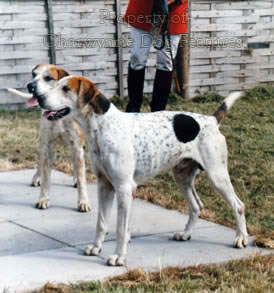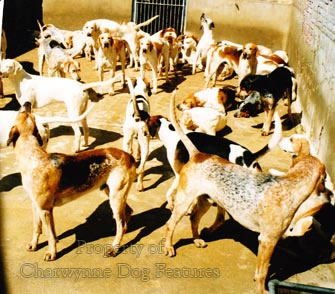692 THE HUNTING HABIT
THE HUNTING HABIT
by David Hancock
 “One of the best features of hunting is that it gives all classes a chance of meeting on terms of equality. In the hunting field all men are equal with the exception of the master and the huntsman – they should be absolute autocrats. The peer must take a back seat if the butcher with a bold heart can pound him over a big fence.”
“One of the best features of hunting is that it gives all classes a chance of meeting on terms of equality. In the hunting field all men are equal with the exception of the master and the huntsman – they should be absolute autocrats. The peer must take a back seat if the butcher with a bold heart can pound him over a big fence.”
Otto Paget, in his Hunting of 1900, JM Dent & Co.
In contemporary Britain, consensual moral vanity has invaded the sphere of individual conscience and instigated major change, certainly creating changes in hunting habits, and not entirely to the benefit of the quarry. Nowadays the word hunting has come to mean foxhunting, which has wider-ranging perils. The mean-spirited Hunting with Dogs Act was aimed at ‘men in red coats’ and admitted to be, by more honest politicians, an act of class warfare rather than an animal welfare move. The fact that it has achieved what Danish kings, Norman knights and urban-dwelling wealthy reformists failed to do over a whole millennium: the denial of a working man his right to hunt, seems to have escaped contemporary socialist thinking. In his pretentiously entitled biography, A Journey, former prime minister Blair admitted that the Act was ‘a fatal mistake’, admitting that ‘I started to realize that this wasn’t a small clique of weirdo inbreds delighting in animal cruelty, but a tradition, deeply embedded by history and profound community and social liens, that was integral to a way of life’.
There is rich irony in the fact that communist gurus such as Lenin and Engels were keen hunters, the latter riding to hounds with the Cheshire hunt. There is sadness in seeing maimed foxes struggling to survive in remoter country areas; if foxes have to be controlled then surely the most humane method of dispatching them should be pursued. The bare fact that this is best achieved by the lead Foxhound and not a riskier shotgun blast seems to have little appeal to today’s self-serving welfarists. Personal prejudice should never override realistic humanity. Foxhunting is casually described as a country sport, but at worst it is in reality a form of humane enlightened pest control, which has both shaped our countryside and created a rural pursuit which enjoys a dedicated following.
In his mighty tome An Encyclopaedia of Rural Sports of 1870, Delabere Blaine summed up hunting in Britain down the ages: “The records of the British chase, previous to the Roman invasion are few and uncertain…The invasion of the Romans did not probably restrict the venatorial pursuits of the Britons…The Saxons, in common with all the northern intruders, were much more attached to hunting than the Romans…Early in the fourteenth century hunting was becoming an organized as well as a popular pursuit…the fox also became an object of the sportsman’s search in the succeeding centuries…Of hunting generally it may be remarked, that it became truly an organized pursuit during the last century only, since which time considerable alterations have occurred in the practice of it. Indeed, the opinions and habits of the sportsmen themselves, the horses they ride, and the dogs they employ, have all been for some years past undergoing a gradual change.” If one word had to be chosen to typify the hunting habit in Britain it would have to be ‘change’, constant change.
In his book Monarchy and the Chase of 1944, ‘Sabretache’ was writing: “All these Norman kings, whatever their misdeeds in other regions, were unquestionably imbued with a genuine love of hunting, the conqueror being both knowledgeable, and, at the same time, the best veneur, and, likewise, the man who did a very great deal to improve the breed of the indigenous horse. He knew what to do and he did it. Though the Conqueror did not initiate hunting in England, to his credit it must be recorded that he added a few weighty stones to the foundations laid by the Saxons.” What disparate influences: ancient British, Roman, Saxon, Norman styles, and each one affected by social attitudes too. The quarry too played a key part in its development here:
“If any huntsman had been bold enough to suggest to William the Conqueror that stag hunting was on the way out and that the noble staghound would be forced to give way to a hound bred to hunt the fox, it is possible he would have been executed on the spot…And it would have sounded like nonsense because, in 1066, and for many centuries afterwards, the fox was vermin and every effort was made to stamp out the species. They were driven into nets, clubbed to death, trapped, and any method was considered good provided it ended in the death of a fox. The stag and the hare reigned supreme although, it must be admitted, it was the practice of many hunts to chase anything that turned up.”
from The Book of the Hound by CGE Wimhurst, Muller, 1964.
“The eighteenth century was the golden age of field sports in Britain. Shooting over pointers, which were also expected to retrieve the game shot, hunting with the new breeds of foxhounds, coursing, or hare or otter hunting were the regular sports of the countryside…Buck hunting was also growing less common and red deer, as noted, was only extensively hunted in the West Country."
from Hunting and Shooting by Michael Brander, Weidenfeld & Nicolson, 1971.
Those two quotes summarize very neatly the way in which hunting habits can change century by century, and, as the twenty-first century is already indicating, external pressures on hunting can have highly significant, but hopefully not permanent, effects. In Victorian times, the nobility and landed gentry had a huge influence on dogs, sporting breeds especially. In his Monarchy and the Chase of 1944, ‘Sabretache’ wrote: “If Victoria the Good had been a hunting lady, she would have at once realized the fact that when she came to the throne her country was little short of a hunting paradise. Hounds had improved out of all knowledge; the well-bred hunter was in similar profusion…” There were 200 packs of Foxhounds, with the Duke of Beaufort and Lords Donerail, Portsmouth, Coventry and Bentinck taking a keen interest. The Dukes of Gordon and of Richmond kept Deerhounds, as did Lords Seaforth, Tankerville and Bentinck. Lord Bagot showed Bloodhounds and Lord Wolverton ran a pack of them in Dorset, later sold to Lord Carrington in Buckinghamshire. The Marquis of Anglesea kept Harriers and Sir John Heathcote-Amory favoured Staghounds. Lord Lurgan's coursing Greyhound Master McGrath won 3 Waterloo Cups out of 4. The Duke of Atholl maintained a pack of Otterhounds. But this was a time of social change, with newly wealthy sportsmen entering the hunting field as well as the country sports world more generally.
The early years of the twentieth century saw significant changes in hound-breeding; the importance of an infusion of Welsh Hound and Fell Hound blood into many packs, as well as the value of the Belvoir stallion hounds, was recognized. More importantly, the emphasis on drive, nose, cry and pace led to the development of more athletic lighter less-boney hounds. The main instigator of this was Sir Edward Curre at the Chepstow Hunt. By the end of the Great War he had already had some twenty years of combining the merits of top quality English bitches with proven Welsh stallion hounds, usually in a white or light jacket. He inspired others like Sir Ian Amory of the Tiverton and Isaac Bell of the South and West Wilts and influenced the Heythrop, North Cotswold and Cattistock packs. Out went the massively-timbered ‘shorthorns’ and less favoured were the classic tricoloured Belvoir markings. By the 1930s, the ‘Peterborough type’ had been superseded by the lighter-boned, pacier hounds with better stamina. The importance of the ‘female line’ in breeding was recognized, overcoming the slavish adherence to the ‘sire-dominated’ thinking of the previous century.
But it could be said that after the First World War, hunting with hounds moved on to become riding to hounds. The distinguished American MFH, Joseph B Thomas, describes this well in his important book, Hounds and Hunting Through the Ages, published in New York in 1928: “In Britain hunting to ride is now all the vogue as opposed to riding to hunt: quick bursts lifting hounds to holloas and over numerous foxes have played havoc with veritable hunting in the old sense…The deliberately dishonest huntsman is inexcusable, he ruins hounds and he deceives his followers. Cheering hounds to a false line, laying drags, dropping foxes at the end of a drag line, making his field believe hounds are hunting a fox when they are in reality hunting the huntsman, expressed mildly some of his whiles…In England, where a huntsman’s tips depend largely on his reputation as a ‘smart’ huntsman giving the riding contingent many short quick gallops, it is also a great temptation for a huntsman to be euphemistically speaking a faker.” These are strong words, but need noting. For me the ‘thrill’ of the chase lies in watching hounds at work, not horses jumping, much as I enjoy steeplechases and point to points.
After the all-time high of hunting in the 1930s, the Second World War, as had the First, devastated the hunting field, the packs especially. The requirement for maximum food production, extensive afforestation and wide-reaching social change altered not just the hunting country but public attitudes to the sport. Significantly, the leading animal charity, the RSPCA, despite having been founded by the keen foxhunter Richard Martin, mounted a much more militant opposition to all hunting with dogs. The anti-hunting pressure-group, the League Against Cruel Sports or LACS, managed to capture the new generation of young activists, as well as considerable funding. The defection from LACS of three leaders, on the grounds of their realization that a hunting ban would not prevent the death or suffering of foxes and might well increase suffering and death-rates, has been strangely overlooked by both loud-voiced politicians and the lazier mainstream media outlets. Urban living has allowed so many to see nature as cosy and cuddly and not cruel, as it is. The Countryside Alliance has a huge job on its hands not just to inform and bring balance to the hunting debate, but to overcome what Van der Post has described as ‘town-thinking’. One of my sporting colleagues argues that “The ‘Townees’ have replaced the Normans in suppressing the English countryman”; he may well have a point!
“The opponents of hunting see it as a kind of primitive battle, in which the quarry is overcome by unfair military tactics and a cruel war of attrition. For the hunt followers, however, the hunt is an equal contest, governed by rules of engagement which respect the hunted animal while giving the greatest possible scope to the hounds that are pursuing it. True, the quarry is singled out for a life and death struggle which it did nothing to provoke. But this ‘singling out’ exalts the fox or stag in the eyes of its pursuers and imposes on them the ethic of fair play.”
Professor Roger Scruton, writing in the Winter 2009 issue of the magazine ‘Hunting’.